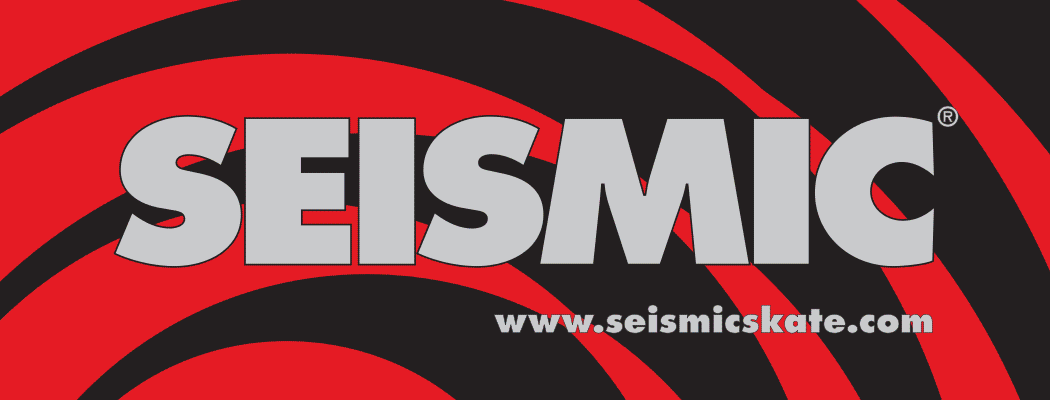

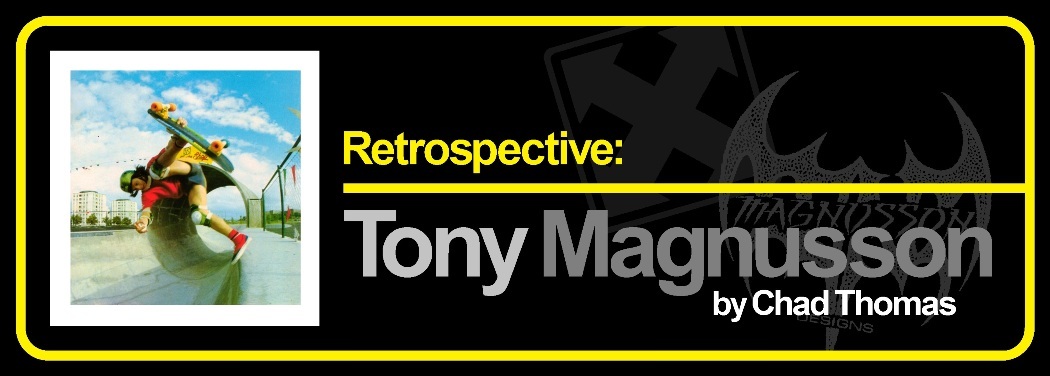
Tony Magnusson, aka “T-Mag”, aka “Tony Mag”, aka “The Maggster” (I totally just made that last one up), was a founding member of H-Street Skateboards, making him one of the first pro skaters to form and run a successful rider-owned board company, along with longtime friend Mike Ternasky.

Tony Magnusson at Osiris HQ, Carlsbad, California, Fall 2017. Photo: Chad Thomas
Their brand “H-Street” featured innovative designs like the ‘Hell-Cave’, a deep concave running from tip-to-tail; a feature that has become the standard among top street and vert skaters.
On the topic of ‘origins’ Mag had this to say:
“H-Street was born in the early 80’s, just as skateboarding was coming back from being all but dead. I had worked at the UWS [Uncle Wiggley Skateboards] board factory in San Diego and learned how to build all sorts of cool and hi-techy boards, which I still ride to this day. Lots of carbon, and other fun stuff.”
Tony on his early years:
“When I was a 13 year old kid in Sweden, and I found skateboarding, a whole new universe opened up for me. And it was not just the riding; it was more of the lifestyle and the attitude that I regarded as an American culture that was kind of foreign to us. Both American and British music played a huge role in this culture also, with the introduction of punk rock and heavy metal.”
When I asked Mag how he discovered skateboarding in the first place:
“At the beginning of 1976, nobody had ever heard of skating. By the end of the year, everyone had one…. literally overnight in Sweden, it spread like wildfire. It was great to have a front-row seat. Along with punk-rock, skating helped the youth take back their country in the course of one year. Alph Erikson also opened the “New Sports” sport complex, which was Sweden’s first indoor skatepark (fashioned after Southern California parks & culture), complete with graffiti-filled walls. By the end of the year, I was pretty well known.”
(Not too bad for a kid who’d never seen a skate deck 12 months prior!)
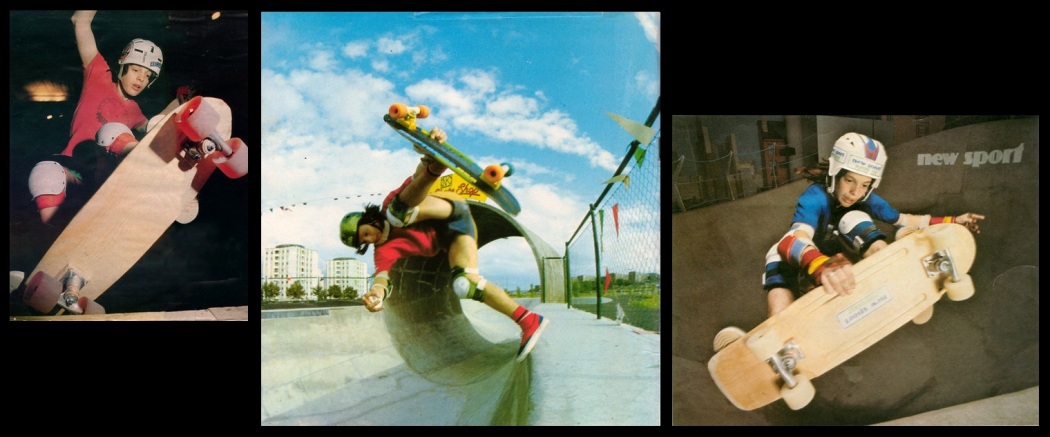
Left to right: Tony in 1977 (14 years old) on a board he made in woodshop; footplant in Gothenburg, sweden, Circa 1977; frontside air, 1978. All photos from the Tony Magnusson archives.
“When I was 16 and I made it to California (in 1980), I found that skateboarding had been left for dead; parks were closing, many of the classic 70’s companies were gone. Yet in a way, it left skateboarding with only the most dedicated riders and industry types. It was a time when you felt like all of skateboarding was a brotherhood, and a sacred secret we all shared. I also thought that skateboarders were the gnarliest and most hardcore people around, thus the most real and honest people. Everyone else was kind of a fake and a phony. Skateboarders just said it the way it was, no games, spin or other bullcrap.
“In a way, I thought everyone else was wearing a mask, hiding who they really are. But not skateboarders. When it was time to figure out a graphic for my first Pro board, I searched long and hard for something that I thought was meaningful to me and perhaps would mean something to someone else too. I found the tragic-comic masks, often symbolizing theater drama and reflecting the tragic and happy aspect of life in general. To me, they are also a good metaphor for the masks people wear.”
Upon his return to Sweden, he got a job and saved every dime he made for a year and a half. The now seventeen-year-old sold everything he had, and bought a one-way ticket back to San Diego in 1980. This began what would become one of the most prolific careers in professional skateboarding.
I asked him about the ‘California attraction’ as a young kid in Sweden. His response:
“It was inherently known that skateboarding was born in Southern California. Magazines, and brands like Sims, Santa Cruz, Powell, and Kryptonics were all pointing us toward Southern California.”
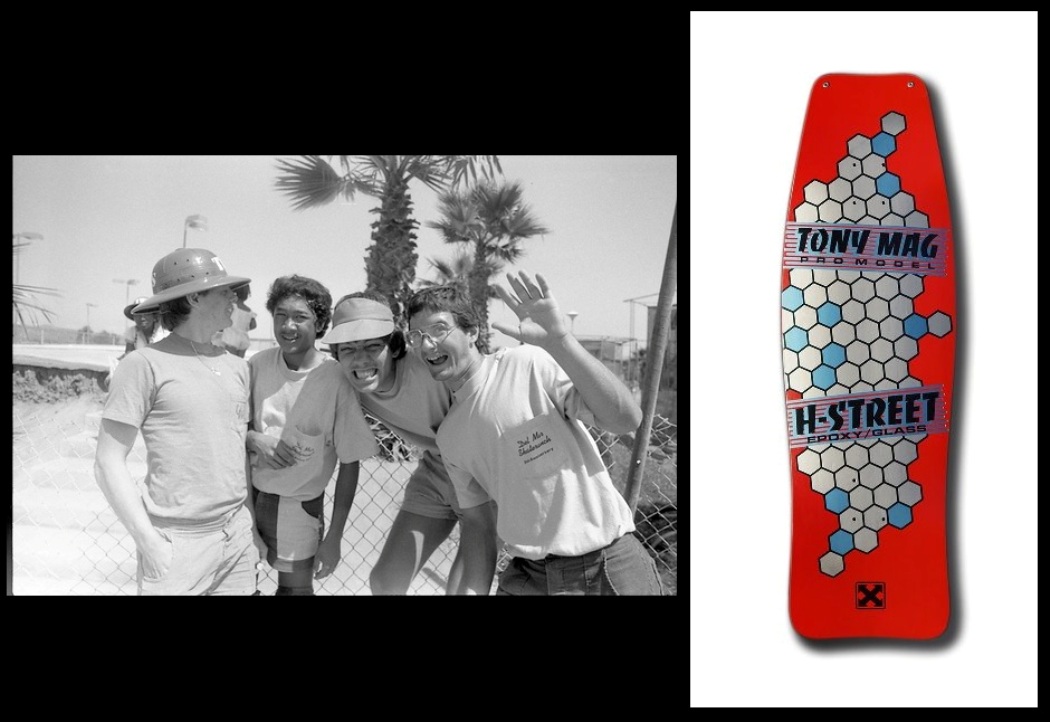
Left: The Uncle Wiggley Skate Team at the famous Del Mar Skate Ranch, (L-R) Mag, Adrian Demain, Peter Percosan & Doug Ring, photo from the Tony Magnusson archives. Right: A recent H-Street reinterpretation of Mag’s Uncle Wiggley pro model, photo courtesy of H-Street Skateboards.
Before the co-creation of the H-Street ‘super-group’, Mag joined Uncle Wiggley’s, a San Diego based skate company that operated in the early ‘80s. After testing some boards that a few Del Mar Skate Ranch rippers had designed, Tony came on board and put every dime he had into the company. Unlike many brands at the time [and since], Uncle Wiggley actually made their own boards; because of that, they were able to produce and market some extremely progressive deck constructions, including foam/kevlar and epoxy/glass models. But after a few years of printing boards instead of skating, Tony decided to leave Uncle Wiggley for his own division (Magnusson Designs) at Sure Grip.
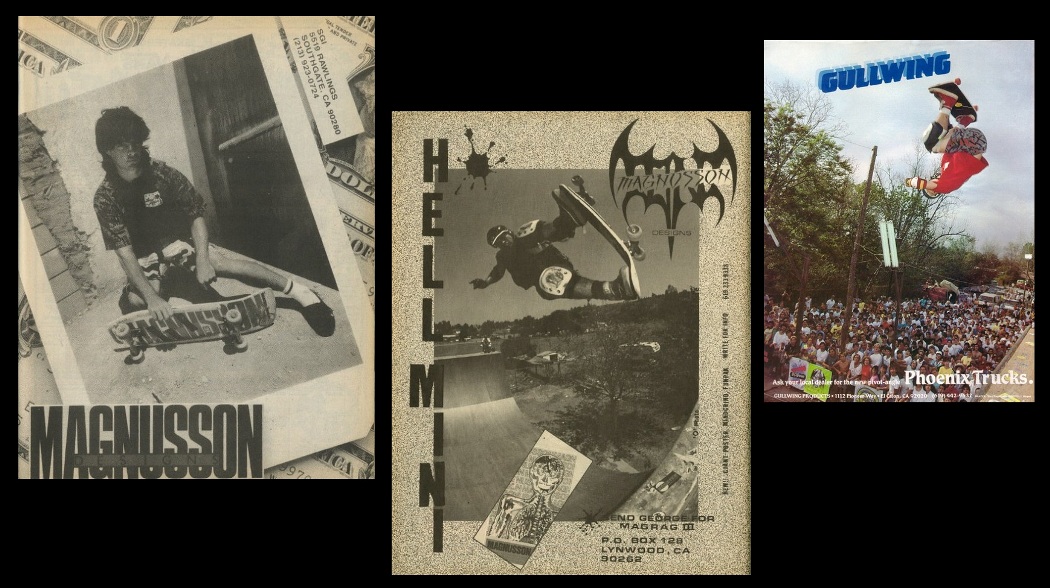
Left: Magnusson Designs Ad from 1986. Center: Magnusson Designs Ad from 1987. Right: Gullwing ad featuring Mag’s sky-high McTwist, Houston, Texas, circa 1988.
When asked about the shift from Magnusson Designs to H-Street, Mag replied:
“Steve Steadham started Steve Steadham Designs (SSD) through Sure Grip, and invited me along to start my own. In 1985, I ran into Mike Ternasky at a skate camp. He was like the parking lot cop, monitoring where we could and couldn’t skate. I wasn’t big of following rules; it was a little contentious. We quickly found common ground, as we came from different backgrounds (Mag pro skating, Mike was college educated)… through brainstorming we decided to ‘reinvent the wheel’ in terms of how a company should be ran, and that became H-Street.”
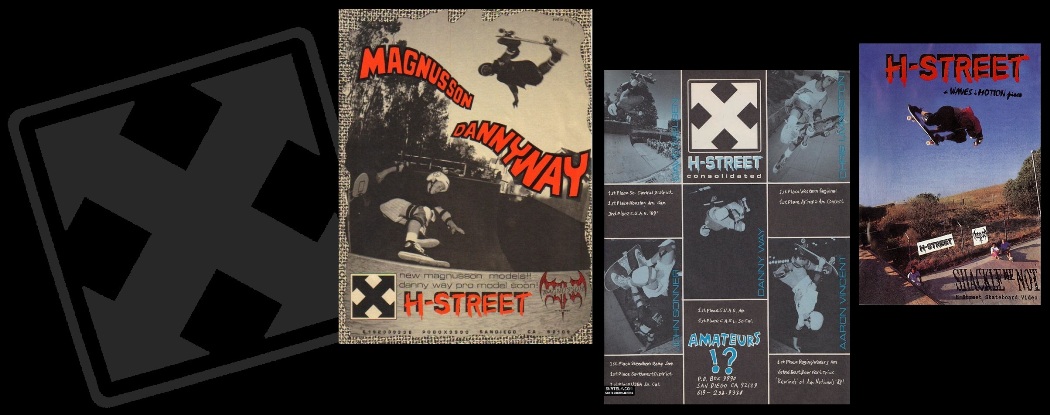
Left to right: Tony Mag and a young Danny Way pair up for an H-Street ad, 1988; H-Street contest standings ad, 1989; H-Street’s groundbreaking “Shackle Me Not” VHS video cover, 1989.
Mike and Tony built what would become one of the most respected, stylish and progressive teams we’ve ever seen. With riders like Matt Hensley, Ron Allen, John Schultes, Art Godoy, and Eddie “El Gato” Elguera, as well as a 14 year-old wunderkid named Danny Way, the team was stacked and became known as “The Magnificent 7”, Mag being the seventh.
It was during this period in which the two partners (Tony & Mike) began experimenting with filming and editing videos themselves. They didn’t have the budget of companies like Powell-Peralta or Santa Cruz. From this act of DIY ingenuity (which Tony fully credits Mike for the idea/inspiration of) and creativity, a new style of video was born –a style which is still emulated today. Pick a skate video, any skate video, and you’ll see the H-Street signature “follow cam/riders-eye” approach pioneered by this group.
When I spoke with Mag about this topic, he recalled:
“We were looking at the Powell Bones Brigade -with their full film crews, pro-grade cameras, and lighting- and just thought, ‘We don’t have those kinds of funds, but there’s gotta be a way’. So we found some hand-held consumer video cams, and taught ourselves how to edit. We just did what we had to do.”
In 1991, Mike left H-Street to start Plan B.
“Mike wanted to go do his own thing. The band broke up”
On May 17, 1994, Tony’s friend and co-conspirator Mike Ternasky was hit and killed when an elderly woman failed to stop at a stop sign. Mike died as a result of the tremendous impact; he was only 28 years old.
After the end of H-Street, Mag kept rolling… right into Evol Skateboards, which he founded in 1993 with Niko Achtipes. Evol evolved from skateboards to clothing, snowboards, boots & outerwear. This is probably a good time to point out that Tom Sims himself taught Tony how to press snowboards. So you know they were legit, not just some cheap knock-off.
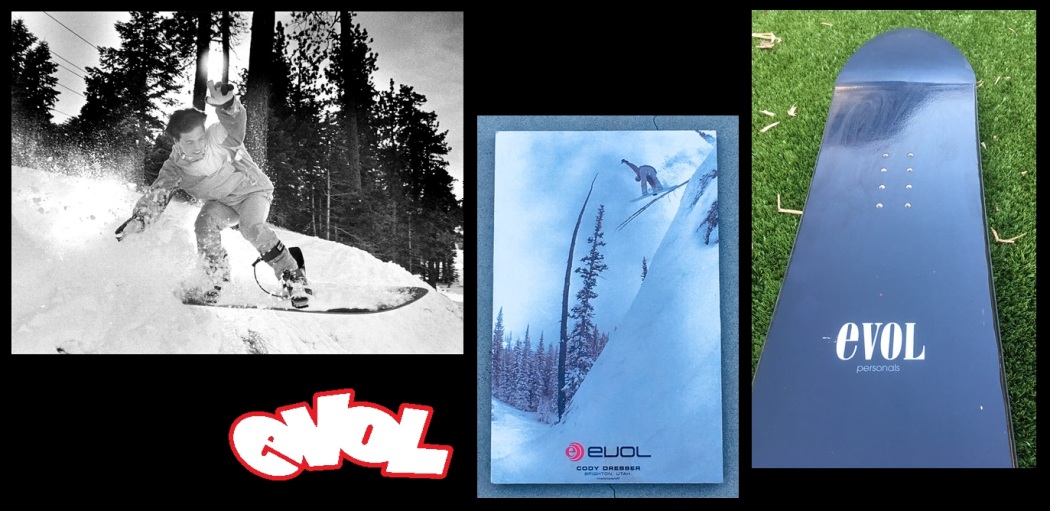
Left to right: Tony at Mountain High on one of the first Evol snowboards, 1988; Evol logo; original shop ad, courtesy of Sk8supply.com; an original (never mounted) Evol Personals 154. Photo: Chad Thomas
In 1995 they introduced the Evol Casuals line of shoes, which quickly became Evol’s most profitable category. Due to conflicts with other deck & clothing sponsors, Tony and Niko found it difficult to get non-Evol riders to wear their shoes. In 1996, the boys came up with, as it turns out, a very effective and forward thinking marketing solution: the shoe division was re-branded as Osiris Footwear, with the original team of Gershon Mosley, Dave Mayhew, Tyrone Olson, and Adam McNatt.
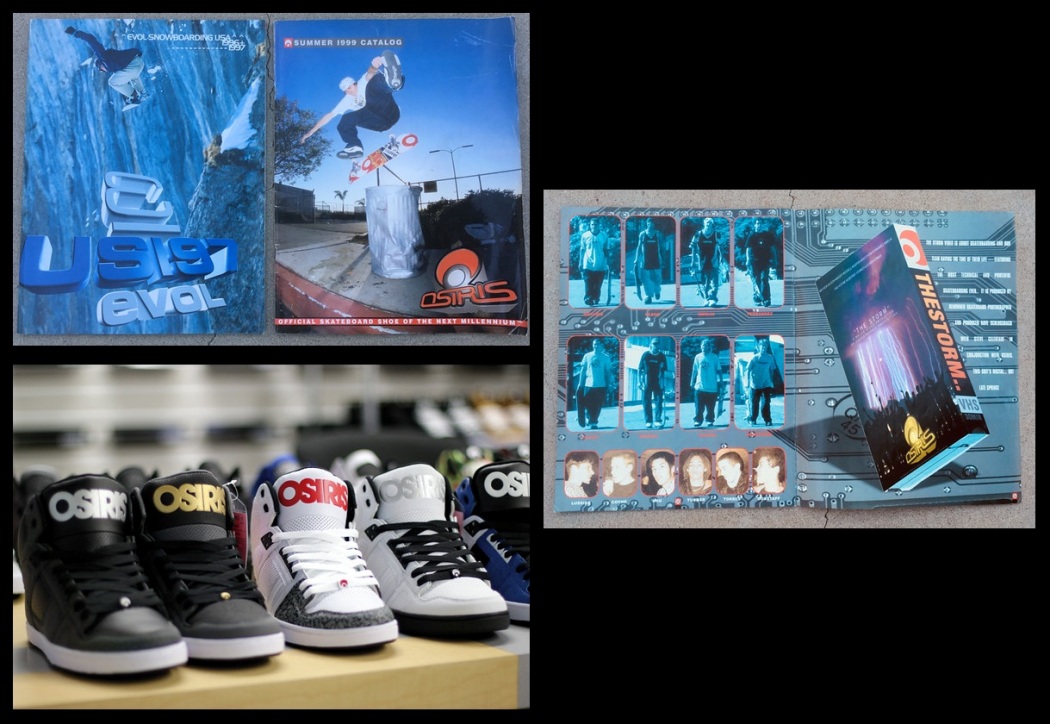
Clockwise from top left: Original Evol and Osiris catalogs, courtesy of Sk8supply.com; Osiris Hi’s at Osiris HQ in Carlsbad, California, 2017. Photos: Chad Thomas
The Evol Skateboards brand continued on until 1998, while Osiris continues to this day producing high quality kicks with creative graphics and styles for all types of riders and outdoor enthusiasts.
Be sure to check out part two of our Mag retrospective, “Resurrection”, coming next month, featuring the original H-Street crew and a reunion out on the high-seas, complete with live punk-rock and floating half-pipes.
Until then, skate everything!

